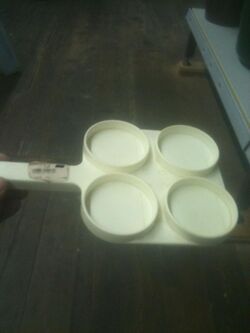California mastitis test
Topic: Medicine
 From HandWiki - Reading time: 2 min
From HandWiki - Reading time: 2 min
The California mastitis test (CMT) is a simple cow-side indicator of the somatic cell count of milk. It operates by disrupting the cell membrane of any cells present in the milk sample, allowing the DNA in those cells to react with the test reagent, forming a gel.[1] It provides a useful technique for detecting subclinical cases of mastitis.
Development
Whiteside described a reaction between sodium hydroxide and milk that resulted in the thickening of mastitic milk.[2] The utility of this reaction as a field test was limited by the fact that the reaction was sometimes difficult to observe, and would eventually occur even in normal milk. A refined version of the test, which enhanced its sensitivity, and eliminated the confounding effect of milk fat, uses an anionic surfactant, which forms a gel with the DNA in somatic cells in the milk.[3]
Use
A four-well plastic paddle is used, one well being for each quarter of the cow to be tested. Foremilk is discarded, and then a little milk drawn into each well. An equal volume of test reagent is added, and gently agitated. The reaction is scored on a scale of 0 (mixture remains unchanged) to 3 (almost-solid gel forms), with a score of 2 or 3 being considered a positive result.[4] A special reagent for the test is marketed under the name 'CMT-Test', but domestic detergents are frequently used instead, being cheaper and more readily available. Fairy Liquid is as suitable as a reagent for the CMT, although many cheaper detergents are not.[5]
References
- ↑ David White, Michael Walmsley, Alvin Liew, Rod Claycomb and Graeme Mein (2005): "Chemical and rheological aspects of gel formation in the California Mastitis Test", Journal of Dairy Research, 72:115-121
- ↑ W. H. Whiteside (1939): "Observations on a new test for the presence of mastitis in milk." Canadian Public Health Journal 30:44
- ↑ Schlam, OW; Noorlander, DO (1 March 1957). "Experiments and observations leading to development of the California mastitis test". Journal of the American Veterinary Medical Association 130 (5): 199–204. PMID 13416088.
- ↑ "California Mastitis Test" , Milking Management, retrieved 2008-11-18
- ↑ Leach, KA; Green, MJ; Breen, JE; Huxley, JN; Macaulay, R; Newton, HT; Bradley, AJ (8 November 2008). "Use of domestic detergents in the California mastitis test for high somatic cell counts in milk.". The Veterinary Record 163 (19): 566–70. doi:10.1136/vr.163.19.566. PMID 18997186.
 |
 KSF
KSF
